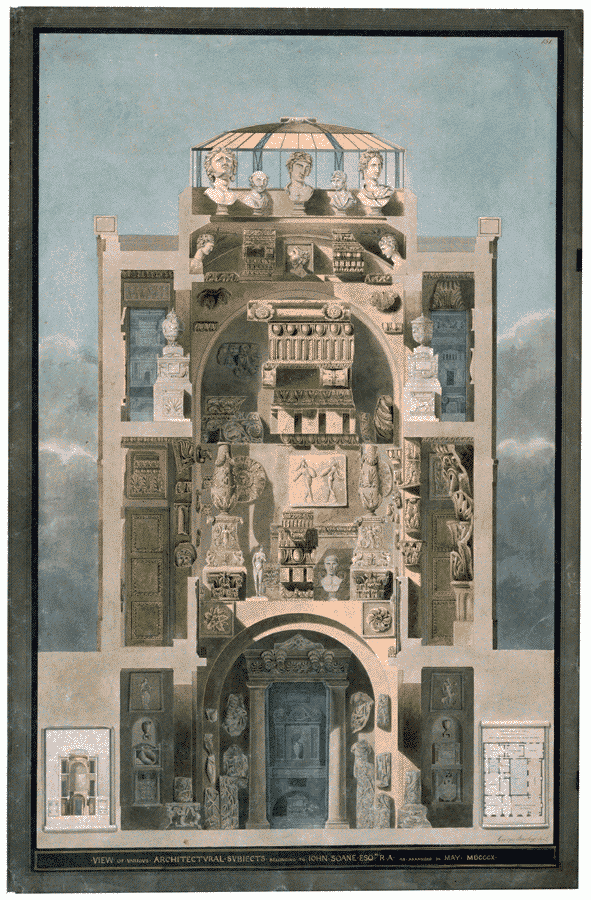We’re deep in the Soane Museum, the house and office that Sir John Soane designed in Lincoln’s Inn Fields. It’s dusk: in the Dome Room, blue light filters down while candles cast a flickering light over relics of antiquity. These are the urns, statues and fragments of buildings that are part of Soane’s collection, a dense encrustation covering almost every surface of the complex spatial architecture. More than mere decoration, they were Soane’s carefully constructed essay on the nature of architecture.
We’re cracking open a fresh pack of 2Bs, here to draw among Soane’s stuff just like his students once did. Soane’s house is more than architecture: it’s an argument for architecture, an experiment and a pedagogical device rolled into one.
We’ve assembled a game group of students to help us explore the relationship between architecture and representation. And the Soane acts as the perfect venue: a place where representation of architecture and architecture itself blur into a single scene. Take the ‘cupola’ above the study roof. It appears to be part of the ‘real’ architecture of the building, yet it’s actually a repurposed piece of a model from one of Soane’s schemes. Or Canaletto’s view of Venice, hung in the picture gallery such that, seen from the Dome area, it appears to be the view from the window. The house and its collection are a constant flux between reality and representation.
In fact, this might be Soane’s central lesson: that architecture, even at the level of a building, is always a form of representation: its representational qualities are not different from its ‘real’ qualities as a building, but are simultaneous. It’s an argument that makes the act of drawing fundamental to the creation of architecture. Architecture starts with the drawing, and as it becomes more real, it carries with it that first conception of what space might be from the graphic plane.
For Soane, this meant drawing as a form of measurement, an empirical system where even shadow is a register of distance. For Ruskin, drawing was something else, starting with an understanding of the phenomenon you were trying to depict. For Kandinsky, a different conception: about tension and gravity within the picture plane. From each of these examples we took a drawing lesson, and guided by them step-by-step, we used the Soane as a test bed, exploring the relationship between architectural space and representation. It proved surprisingly hard to switch between these different conceptions of drawing: lines mean different things in each, and the paper itself transformed – sometimes appearing as a flat surface, sometimes as a deep space.
It seems anachronistic to think about the act of drawing and architecture now we have computing power that can almost instantly render a scene for us. CGI is the dominant mode of contemporary architectural communication. It presents an apparently ‘real’ image of the world – photorealistic and perspectival – and is a dangerously plausible fiction. The buildings that result are full of the kinds of things that CGI excels at: architecture that curves and shines as if it were still glowing on the screen of its designer.
We’re smart enough to know now that photography is far from a transparent window onto the world: it frames and constructs its own image. If we think of CGI as the logical conclusion of the perspectival project, we should also remember that perspective itself is not really the way the world looks but an artificial construction. In opposition to these forms of image-making, we might deploy the vast processing power that sits on our desktops to other ends. And one of those ends might well be exploring drawings’ intrinsic artificiality.
Architecture, it seems, has given over the act of representation – the way one constructs space on the picture plane, the projection that one might use, the way in which shadow is depicted (or not) – to the default algorithms of drawing programmes. And in doing so, it has relinquished the possibilities of drawing to act as the place where architectural ideas might begin.
Now, I’m no technophobe. I’m not arguing that we should throw down our mice and take up quills. What I am arguing is that, especially now, with the incredible possibilities that digital tools have given us, it seems a dereliction of graphic duty that we are failing to take advantage of them in any meaningful way. After all, as Soane continues to teach us (as do Ruskin, Kandinsky and others), the way we represent the world is also the way we create it.
This article was first published in the October 2015 issue.
